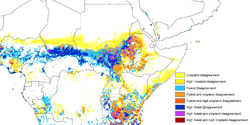Organization:Geo-Wiki
| Original author(s) | International Institute for Applied Systems Analysis |
|---|---|
| Website | www.geo-wiki.org |
Geo-wiki is a platform for engaging citizens in both biophysical and socioeconomic monitoring. It aids in both the validation of existing geographical information and the collection of new geographical information through crowdsourcing.[1][2] Using tools such as Google Earth, Bing Maps, Geotagged photographs and the internet, individual volunteers are able to contribute valuable information. It provides feedback on existing information overlaid on satellite imagery or by contributing entirely new data. Data can be input via the traditional desktop platform or mobile devices, with campaigns and games used to incentivize input. Resulting data are available without restriction.
Land cover validation
Global land cover validation exercises are feasible as images less than 2.5 meter resolution provide very detailed information on land cover with global coverage of at least 20%[3] with more high-resolution, up to date images continuously being added. Internet tools such as Google Earth offer enormous potential for land cover validation.[4] The use of Volunteer Geographic Information for land cover validation studies seems even more relevant as Google Earth has been used for the recent validation of remote sensing derived products e.g., the European forest cover map[5] as well as the latest global land cover map GlobCover.[6] Google Earth allows wider audience to be involved in a validation exercise.
Applications of Geo-wiki go beyond simply improving land cover. An application helps to predict future deforestation in Central Africa,[7] combining five existing cropland data sets from sub-Saharan Africa to create a new map which has higher accuracy than existing maps. This should reduce uncertainty and improve predictions in land use, vegetation, climate change, and earth systems modeling. Scientists from several research institutions describe development of the map in Geophysical Research Letters, along with the application of Geo-Wiki.[8]
Gamification
References
- ↑ Remote Sensing | Free Full-Text | Geo-Wiki.Org: The Use of Crowdsourcing to Improve Global Land Cover. Mdpi.com. doi:10.3390/rs1030345. http://www.mdpi.com/2072-4292/1/3/345. Retrieved 2012-01-06.
- ↑ See, L., Mooney, P., Foody, G., Bastin, L., Comber, A., Estima, J., Fritz, S., Kerle, N., Jiang, B., Laakso, M., Liu, H.-Y., Milcinski, G., Niksic, M., Painho, M., Podör, A., Olteanu-Raimond, A.-M. and Rutzinger, M. (2016) Crowdsourcing, Citizen Science or Volunteered Geographic Information? The Current State of Crowdsourced Geographic Information. ISPRS International Journal of Geo-Information, 5 (5). p. 55.
- ↑ Potere, D. Horizontal positional accuracy of google earth's high-resolution imagery archive.Sensors 2008, 8, 7973-7981
- ↑ Butler, D. The web-wide world. Nature 2006, 439, 776-778
- ↑ Pekkarinen, A.; Reithmaier, L.; Strobl, P. Pan-European forest/non-forest mapping with Landsat ETM+ and CORINE Land Cover 2000 data. ISPRS J. Photogramm. 2009, 64, 171-183
- ↑ Defourny, P.P.; Schouten, L.; Bartalev, S.; Bontemps, S.P.; Caccetta, P. et al., Accuracy Assessment of a 300 m Global Land Cover Map: The GlobCover Experience, 2009
- ↑ Anjali Nayar (2009-11-20). "Model predicts future deforestation : Nature News". Nature (Nature.com). doi:10.1038/news.2009.1100. http://www.nature.com/news/2009/091120/full/news.2009.1100.html. Retrieved 2012-01-06.
- ↑ "Cropland for sub-Saharan Africa: A synergistic approach using five land cover data sets". Agu.org. http://www.agu.org/pubs/crossref/2011/2010GL046213.shtml. Retrieved 2012-01-06.
External links


